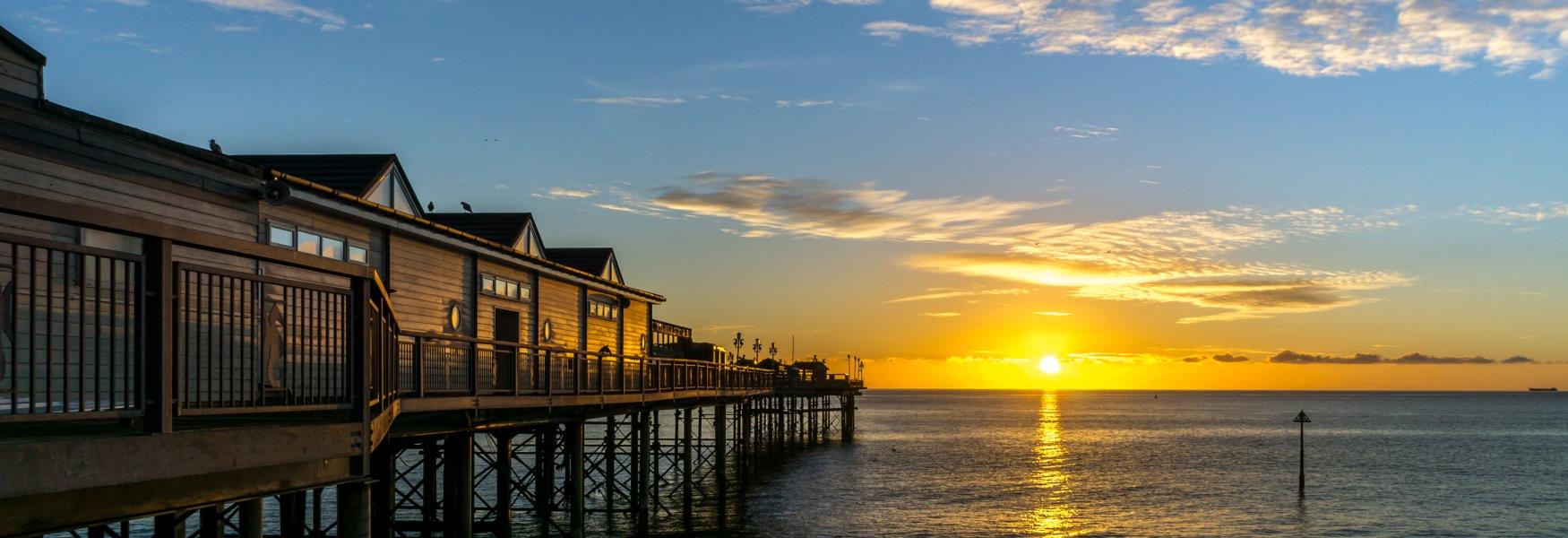-.jpg) South Devon, with its stunning coastline, rugged cliffs, and dramatic seascapes, is a treasure trove of natural beauty and maritime history. Among its most captivating features are its lighthouses—iconic structures that have guided sailors safely for centuries.
South Devon, with its stunning coastline, rugged cliffs, and dramatic seascapes, is a treasure trove of natural beauty and maritime history. Among its most captivating features are its lighthouses—iconic structures that have guided sailors safely for centuries.
In this blog post, we’ll journey through some of South Devon’s most famous lighthouses, uncovering their history and their role in shaping our picturesque region.
Smeaton’s Tower, Plymouth
Smeaton’s Tower, a striking red-and-white lighthouse perched on Plymouth Hoe, is one of the city's most cherished landmarks. Its story intertwines innovation, history, and resilience, making it an enduring symbol of maritime heritage.
Originally constructed in 1759 by civil engineer John Smeaton, the tower was the third iteration of the Eddystone Lighthouse. Situated on the perilous Eddystone Rocks, it revolutionised lighthouse construction with its pioneering design. Smeaton used interlocking granite blocks and a curved profile inspired by the trunk of an oak tree, which allowed it to withstand the relentless forces of the sea. This design set the standard for lighthouses worldwide.
After over a century of service, Smeaton’s Tower was decommissioned in 1877 due to the erosion of its rocky foundation. The structure was carefully dismantled and reassembled on Plymouth Hoe, where it stands today as a testament to engineering ingenuity and maritime history.
Visitors to Smeaton’s Tower can climb its 93 steps (including steep ladders!) to reach the lantern room. From there, breathtaking views of Plymouth Sound, the Barbican, and the surrounding coastline await. Along the way, exhibits and restored rooms provide insight into the lives of lighthouse keepers and the tower's operational history.
Beyond its historical significance, Smeaton’s Tower holds cultural and symbolic value. It serves as a reminder of Plymouth's maritime past and its importance as a naval hub. The tower is also a popular backdrop for photographs, weddings, and community events.
Whether you're a history enthusiast, an engineering admirer, or simply someone seeking stunning views, Smeaton’s Tower offers a unique experience. It stands as a beacon of innovation, resilience, and Plymouth's enduring connection to the sea.
Eddystone Lighthouse, Plymouth
The Eddystone Lighthouse, standing in the English Channel 14 miles off Plymouth, is one of the world's most famous lighthouses. Its history is a testament to human ingenuity and determination in the face of nature's relentless power.
The treacherous Eddystone Rocks, submerged at high tide, have posed a significant hazard to sailors for centuries. To address this, the first Eddystone Lighthouse was built in 1698 by Henry Winstanley. Tragically, it was destroyed by a storm in 1703, taking Winstanley and its crew with it. A second structure by John Rudyerd followed in 1709 but succumbed to fire in 1755.
The third lighthouse, constructed in 1759 by John Smeaton, marked a turning point in lighthouse design. Smeaton’s use of interlocking granite blocks and a curved, oak-inspired structure revolutionized lighthouse construction. This engineering marvel stood for over a century and inspired future lighthouses worldwide.
In 1882, a fourth and final lighthouse, designed by James Douglass, replaced Smeaton’s tower. Modern in its construction and materials, it continues to guide mariners safely today. Douglass’ design incorporates stronger foundations and a more advanced lighting system, ensuring its resilience against the elements.
While the Eddystone Lighthouse is not accessible to the public, its legacy can be explored at Smeaton’s Tower on Plymouth Hoe. Smeaton’s Tower, dismantled and relocated to the Hoe in 1877, provides an intimate look at the lives of lighthouse keepers and the engineering behind these beacons of safety.
The Eddystone Lighthouse remains a vital navigational aid and a symbol of maritime history. It stands as a powerful reminder of humanity's ability to adapt and innovate, ensuring the safety of sailors navigating the challenging waters off Plymouth.
Start Point Lighthouse, Kingsbridge
Start Point Lighthouse, located on the rugged headland of Start Point in South Devon, is one of the oldest and most iconic lighthouses in the region. Built in 1836 by renowned engineer James Walker, this lighthouse has been guiding mariners safely through the treacherous waters off Start Bay for nearly two centuries.
The need for the lighthouse arose due to the perilous currents and hidden rocks in the area, which posed a significant hazard to ships navigating the English Channel. Its strategic position on the promontory allows the light to reach far out to sea, making it an invaluable aid for sailors.
The lighthouse was originally powered by oil lamps and reflectors, but over the years, technological advancements have modernised its operation. In 1960, the lighthouse was electrified, and in 1993, it was fully automated. Today, it remains a vital navigational aid, monitored remotely by Trinity House.
Visitors to Start Point Lighthouse can enjoy guided tours that delve into its fascinating history. Climbing the spiral staircase to the lantern room offers stunning views of the coastline and beyond. Along the way, exhibits provide insight into the lives of the lighthouse keepers who once tended the light, often in isolation and challenging weather.
The surrounding area is equally captivating, with the South West Coast Path offering breathtaking walks along dramatic cliffs. Wildlife enthusiasts may spot seals basking on nearby rocks or seabirds soaring above the waves.
Start Point Lighthouse stands not only as a functional beacon but also as a symbol of resilience and maritime heritage. Its commanding presence on the windswept headland continues to capture the imagination of visitors, making it a must-visit destination for history lovers and nature enthusiasts alike.
Berry Head Lighthouse, Brixham
Berry Head Lighthouse, located on the dramatic cliffs of Berry Head near Brixham in South Devon, is a remarkable piece of maritime history. Despite being one of the shortest lighthouses in the UK at just 16 feet tall, its elevated position on the headland makes it one of the highest above sea level, standing over 190 feet above the water.
Built in 1906, Berry Head Lighthouse was designed to guide ships navigating the rocky coastline of Tor Bay. Its innovative design was ahead of its time, being one of the first lighthouses in the country to be fully automated right from the start. Today, it remains operational, its light flashing every 15 seconds and visible for up to 19 nautical miles.
What makes Berry Head Lighthouse unique is its location within the Berry Head National Nature Reserve. The area is rich in wildlife and history, offering stunning coastal views and a peaceful environment. Visitors can explore the remains of Napoleonic forts nearby or enjoy birdwatching, with the cliffs providing a home to colonies of seabirds like guillemots and kittiwakes. On a lucky day, you might even spot dolphins or seals in the waters below.
Though the lighthouse itself is not open to the public, its surroundings offer plenty to discover. The South West Coast Path runs through Berry Head, making it a popular spot for walkers. The on-site café provides a perfect place to relax and enjoy the scenery after a hike.
Berry Head Lighthouse is more than just a navigational aid; it’s a symbol of ingenuity and adaptation. Its small stature yet critical role serves as a reminder that even the smallest structures can have a significant impact, both on maritime safety and the charm of South Devon’s coastline.
Brixham Breakwater Lighthouse, Brixham
Brixham Breakwater Lighthouse, located at the end of Brixham’s mile-long breakwater, is a small yet vital beacon for vessels entering the busy fishing port of Brixham in South Devon. While modest in size, this lighthouse plays an essential role in ensuring the safety of mariners navigating the harbour’s entrance, especially during the region’s frequent misty and stormy conditions.
Built in 1916, the lighthouse marks the outer edge of the breakwater, which was constructed to protect the harbour from the powerful waves and strong winds of Torbay. The light, housed in a compact white cylindrical tower, emits a fixed green light that guides ships into the harbour. Its steady glow is a reassuring presence for local fishermen and visiting sailors alike.
A walk along the breakwater to the lighthouse is a favorite activity for visitors and locals. The path offers stunning views of Torbay, with its sparkling waters and vibrant coastal scenery. On clear days, you can see across to Paignton, Torquay, and beyond, while stormy weather provides dramatic displays of waves crashing against the breakwater.
At the base of the breakwater, Brixham offers a charming mix of attractions, from its colourful harbour lined with fishing boats to its rich maritime history. The lighthouse complements this setting, standing as a reminder of the town’s close connection to the sea.
Though the lighthouse is not open for public tours, its location makes it an accessible and photogenic spot. Whether you’re exploring Brixham’s bustling harbour or enjoying a quiet seaside stroll, the Brixham Breakwater Lighthouse is a small but significant part of the town’s maritime identity and charm. It continues to be a beacon of safety and a beloved landmark for the community.
Teignmouth Lighthouse, Teignmouth
Teignmouth Lighthouse, also known as The Point or Teignmouth Rear Light, is a distinctive feature of the South Devon coastline. Standing proudly on the seafront at the mouth of the River Teign, this charming lighthouse has been guiding mariners safely into the harbour since its construction in 1845.
Unlike many taller and more remote lighthouses, Teignmouth Lighthouse is compact, standing at just 35 feet tall, but it remains a vital navigational aid. Its role is to work in tandem with a smaller companion light, the Teignmouth Front Light, to help vessels align with the safe channel leading into the estuary. The rear light’s bright white beam flashes twice every 10 seconds, a dependable signal for mariners navigating the busy waters of the English Channel and River Teign.
Located near Teignmouth’s bustling promenade, the lighthouse is easily accessible and offers a picturesque spot for visitors. The nearby sandy beaches, colourful beach huts, and views of Shaldon across the river create a perfect setting for a seaside outing.
Teignmouth itself is a vibrant town steeped in maritime history, with a working harbour and a thriving fishing community. The lighthouse serves as a reminder of the town’s long-standing relationship with the sea and its commitment to ensuring the safety of sailors.
While the lighthouse is not open to the public, its surroundings provide plenty to explore, including the South West Coast Path, which offers scenic walks along the cliffs and estuary. Whether you’re enjoying a stroll along the promenade or learning about Teignmouth’s nautical heritage, the lighthouse stands as a modest yet enduring symbol of the town’s connection to the water.
Teignmouth Lighthouse is a gem of South Devon’s coastline, offering charm, history, and functionality in equal measure.
South Devon’s lighthouses are more than functional maritime structures; they are living monuments to the region's seafaring heritage. Each lighthouse tells a story of human ingenuity and the relentless power of the sea.
Plan Your Visit:
When to Go: Spring and summer are ideal for enjoying coastal walks and tours, though the dramatic winter seas can offer equally memorable views. Wondering where to stay? Read more here.
How to Get There: South Devon is well-connected by road and rail, with many lighthouses accessible via scenic coastal paths. Learn more about travelling around South Devon here.
Whether you're a history buff, a photography enthusiast, or simply someone who loves the sea, the lighthouses of South Devon are sure to inspire. They stand as guardians of the coast, reminding us of the bravery of sailors and the enduring allure of the ocean.
Keep up to date with all things South Devon by signing up to our e-newsletter here. We’ll let you know about the latest events, blog posts, competitions and more!
Related
Comments
Comments are disabled for this post.



 to add an item to your Itinerary basket.
to add an item to your Itinerary basket.









